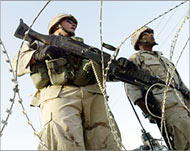Iraqi resistance: Questions remain
Resistance in Iraq against US-led occupying forces has come from several strands since the Iraqi government was toppled on 9 April 2003.

Three broad groupings have been identified: supporters of the former government, nationalists and Islamically motivated groups. Some analysts believe that the resistance lacks any central command.
“Iraq is a cockpit and a frontline for so many different forces in the Middle East – Sunni and Shia, radical and moderate, Persian and Arab,” writes Martin Woollacott in British newspaper The Guardian.
Since US President George Bush declared the end of “major combat operations” in May last year the resistance has intensified in scale and severity.
The hoped for smooth transition of power has turned in to a quagmire, claiming victims from across the board: combatants, civilians, Iraqis, Americans and others.
Baath loyalists
Baath party members, the Fidayin Saddam (Sacrificers of Saddam), army cells and former intelligence and security agents are frequently blamed by the US for the violence.
But the level of support from members of the ousted party in the ongoing resistance remains a matter of conjecture.
The question remains: What is it that the Iraqi Baath party aspires to achieve now that Saddam Hussein and most of his high ranking officials have been arrested?
Zaki Chehab, a political editor for the Arab TV station al-Hayat-LBC, who was one of the first journalists to interview members of the Iraqi resistance, was told by one fighter in Iraq: “We do not want to see our country occupied by forces clearly pursuing their own interests rather than being poised to return Iraq to the Iraqis.”
Army nationalists
The decision made by US occupying authority chief Paul Bremer last May to dissolve the Iraqi army brought about much more than a mass lay off of nearly half a million Iraqis.
It contributed to the existing hostility toward the US cultivated by two US-propagated wars and years of economic sanctions.
Former members of the Iraqi armed forces have been recognised for their role in inspiring a new breed of nationalism, one that takes resistance as its cornerstone.
“Its members are learning fast from the experience of the region, and are already adopting new tactics,” notes Chehab.
“The latest of these is suicide bombing – a weapon which even the strongest counter-terrorism forces struggle to cope with.”
However, beyond the ejection of the occupation armies, there seems to be no clear political programme under the banner of Iraqi nationalism.
Islam and foreign fighters
Emerging Islamic factions are unified by their detestation of the occupation. These groups are widely seen as belonging to branches of Sunni Islam such as the Salafi or Wahabi sect (but there have also been reports of some Shia resistance fighters).
These groups are frequently accused of affiliation with foreign fighters, but it has been difficult to determine their exact number, which countries they are from and to what extent the ‘jihadist’ element is present in Iraq.
‘Sunni triangle’
According to coalition military sources, the most intense resistance stretches west of the capital Baghdad to the towns of Falluja, Ramadi, and north to Tikrit.
The imaginary line that linked these hubs is now labelled the ‘Sunni Triangle’. Indeed, most of the resistance is believed to be indigenous and from the Sunni Arab communities, many with clan and tribal loyalties.
Although resistance in other parts of Iraq is not as visible, many attacks have been reported in various parts of the country, including Mosul, Kirkuk, Karbala and Najaf.
Methods of resistance
Methods also vary. Strikes targeting US military installations and occupying authority compounds employ mostly hit-and-run tactics.
|
|
|
US soldiers in Iraq have come |
During November last year, more than 140 attacks were recorded against US forces in hit-and-run incidences that struck at bases, army installations, military vehicles and foot patrols.
Equally common are attacks using explosive devices, which often strike US army convoys and result in many casualties.
Human bombers, however, have been by far the most damaging tactic, although many of these attacks claimed more civilian lives than those of soldiers.
In January, a bomber killed more than 25 people, mostly Iraqis, when he drove a car carrying explosives into the main entrance to the US army Baghdad headquarters. More than 100 were wounded.
A month later, at least 101 people died when two bombers blew themselves up in the city of Arbil, in northern Iraq, at the offices of the two main Kurdish political parties.
The shooting down of US helicopters, despite extra precautionary measures used to minimise such possibilities, is another technique favoured by Iraqi fighters.
Other targets
The US-led forces are not the only target. Others include prominent political, religious and ethnic figures. They may be targeted to undermine any cooperation with the occupation or simply to stir up disorder.
Three prominent clergymen have been assassinated within the past year. One was Shia Muslim leader Ayat Allah Muhammad Bakr al-Hakim who was killed – along with 83 others – by a bomber outside the Imam Ali mosque in Najaf last August.
Uncounted numbers of ordinary Iraqis and police officers have died in attacks.
Attackers have repeatedly targeted the country’s oil industry. Saboteurs, using either rocket-propelled grenades or explosives, have destroyed large sections of Iraq’s pipelines, especially in the north.
US officials claimed that the aim of the sabotage was to hamper reconstruction championed by the US and its allies.
The total number of attacks and “major incidences” against US forces is averaging 10 to 15 a day, with some media, such as the Arab press, putting the figure as high as 30.
Since the end of “major combat”, the total number of US troops killed has crossed the 550 mark, with an estimated 3000 to 4000 US troops sustaining injuries.
